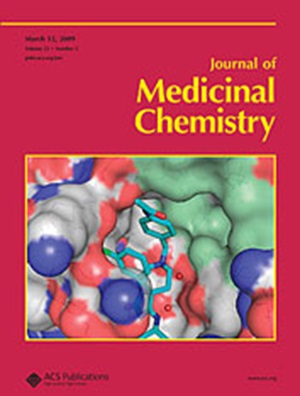长臂酰胺侧链在甾醇14α-去甲基酶(CYP51)抗真菌唑类抑制剂设计中的应用
IF 6.8
1区 医学
Q1 CHEMISTRY, MEDICINAL
引用次数: 0
摘要
真菌耐药性的上升加剧了侵袭性真菌感染的治疗,最常见的是由念珠菌引起的。本研究描述了扩展的“长臂”唑类抗真菌药物的合成,并对野生型和抗性真菌进行了评价。联苯衍生物22是最有效的衍生物,与泊沙康唑相比,对酵母菌、念珠菌和隐球菌CYP51酶(包括耐药菌株)具有较强的抑制活性。S-22与酿酒葡萄球菌CYP51配合物的x射线晶体结构显示,S-22的三氟甲氧基氧与酿酒葡萄球菌CYP51的His381侧链之间存在氢键,这可能是在酿酒葡萄球菌CYP51 Y140F/H、C. parapsilosis和C. auris CYP51 Y132F突变和C. auris K143R突变存在时,S-22与酿酒葡萄球菌CYP51 Y132F的结合和稳定的重要原因。化合物22对白色念珠菌野生型、Y132F和Y132H/K143突变株的计算研究和IC50评估支持MIC观察结果。本文章由计算机程序翻译,如有差异,请以英文原文为准。
Exploring Long Arm Amide-Linked Side Chains in the Design of Antifungal Azole Inhibitors of Sterol 14α-Demethylase (CYP51).
The rise in fungal drug resistance has exacerbated the treatment of invasive fungal infections, most commonly caused by Candida. This research describes the synthesis of extended "long-arm" azole antifungals that were evaluated against wild-type and resistant fungal species. Biphenyl derivative 22 was the most effective derivative, displaying potent inhibitory activity against Saccharomyces, Candida, and Cryptococcus CYP51 enzymes, including in resistant strains, in comparison with posaconazole. The X-ray crystal structure of S-22 complexed with S. cerevisiae CYP51 showed a hydrogen bond between the oxygen of the trifluoromethoxy group of S-22 and the His381 side chain of S. cerevisiae CYP51, which is postulated to contribute significantly to its binding, and stabilization in the presence of the S. cerevisiae CYP51 Y140F/H, C. parapsilosis and C. auris CYP51 Y132F mutations and the C. auris K143R mutation. Computational studies and IC50 evaluation of compound 22 vs C. albicans wild-type, Y132F, and Y132H/K143 mutant strains supported MIC observations.
求助全文
通过发布文献求助,成功后即可免费获取论文全文。
去求助
来源期刊

Journal of Medicinal Chemistry
医学-医药化学
CiteScore
4.00
自引率
11.00%
发文量
804
审稿时长
1.9 months
期刊介绍:
The Journal of Medicinal Chemistry is a prestigious biweekly peer-reviewed publication that focuses on the multifaceted field of medicinal chemistry. Since its inception in 1959 as the Journal of Medicinal and Pharmaceutical Chemistry, it has evolved to become a cornerstone in the dissemination of research findings related to the design, synthesis, and development of therapeutic agents.
The Journal of Medicinal Chemistry is recognized for its significant impact in the scientific community, as evidenced by its 2022 impact factor of 7.3. This metric reflects the journal's influence and the importance of its content in shaping the future of drug discovery and development. The journal serves as a vital resource for chemists, pharmacologists, and other researchers interested in the molecular mechanisms of drug action and the optimization of therapeutic compounds.
 求助内容:
求助内容: 应助结果提醒方式:
应助结果提醒方式:


